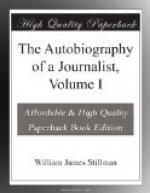The hope of getting much technical instruction from competent masters in England was speedily dispelled. Lessons in water-color I could get at a guinea an hour, and to enter as a pupil with one of the better painters was impossible. Pyne received from his pupils L100 a month. I had calculated how far I could mate my fifty pounds go and put it at six months. By the advice of Wehnert, I applied to Charles Davidson, a member of the New Water-Color Society, for instruction, and went down into Surrey, where he lived, to be able to follow him in his work from nature. He lived at Red Hill, and in the immediate vicinity John Linnell had built his then new home. In the few weeks I lived there I saw a great deal of the old man, one of the most remarkable examples of the old English type I have ever known, and to me as interesting a problem from the religious point of view as from the artistic. Barring differences of the creed, of which I knew and cared nothing (for my own religious horizon had always included all “good-willing men,” and I had no conception of the distinctions of creed which would send on one side of the line of safety an Established Churchman and on the other a Nonconformist), we agreed very well, and in the general impression I set Linnell down as a devout Christian of the Cromwellian type, and he certainly was a man of remarkable intellectual powers, both in art and in theology. His Christianity might have taken a form of less domestic sternness, but I remembered my own father too well to find it inconsistent with genuine piety, though not even my mother ever inspired the awe Linnell and his religious severity excited in me.
Linnell’s landscape seemed to me the full expression of a healthy love of nature, possible only to a moral sanity in the man—a cheery Wordsworthian enjoyment of her, which as a rule I have never found in perfection out of the English school and its derivatives; the outpouring of a robust nature which prefers to see the outer world with the spectacles of no school, and through the memory of no other man; not self-taught in the sense of owing nothing to another mind, but in the sense that what he had learned he had digested and forgotten except as a chance word in the universal gospel of art; technically weak, slovenly in style, but eminently successful in telling the story he had to tell. Even then, with my limited knowledge of painting, he seemed to me to furnish the antithesis to Pyne,—one too careful of style and running to excessive precision, the other too negligent and running into indecision; and this judgment still holds. Of Davidson, my immediate teacher, there was only to be got certain ways of doing certain things, limited to the elements of landscape; how to wash in the sky, to treat foliage in masses, and those tricks of the brush in which the English water-color school abounds; but no larger views, or more individual, of art itself. What he taught was, perhaps, what I most needed to learn, but I was already too far on the way to learn it easily.




